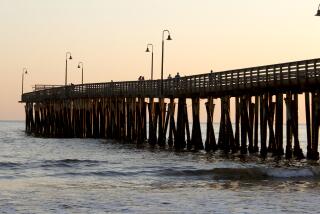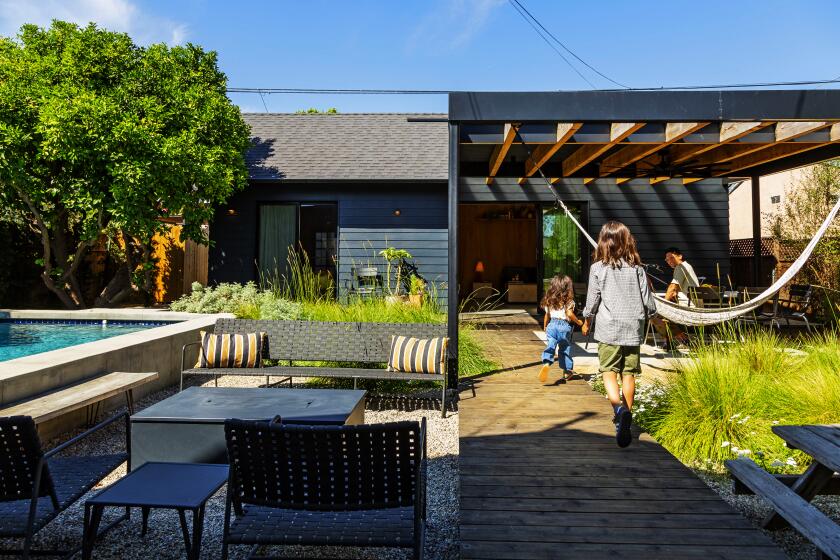Rustic Canyon Ruin May Be a Former Nazi Compound
- Share via
Southern California has been the cradle to many odd cults, credos, utopias and dystopias. Among the most mysterious are the ruins of a Rustic Canyon enclave once known as Murphy Ranch.
The mansions of Hollywood elite -- Whoopi Goldberg, Bill Cosby, Steven Spielberg -- sit in splendor atop the ridges of the canyon in the Santa Monica Mountains. But far below, on its secluded and woodsy floor, stand the eerily burned-out and graffiti-scarred remains of concrete and steel structures, underground tunnels and stairways leading from the top of the canyon to the bottom.
Wrapped in canyon lore, the remnants are believed by one local historian to be those of a small, short-lived colony of Nazis. Although no one can say with certainty who lived there or what they did, Randy Young, a former commercial photographer turned book publisher, said his research indicates that it could have been home to up to 40 local Nazis from about 1933 to 1945.
“It’s extremely difficult to connect all the dots; too many have been erased,” said Young, who has studied local history. He learned about the ranch while growing up in Rustic Canyon. His mother, Betty Lou Young, included the Nazi theory in her 1975 book on the history of the canyon.
Young continued his mother’s research into the enclave, relying heavily on decades of oral histories, architectural plans, documents and letters to come to his conclusion that it was a Nazi colony. The strongest links, he said, come from the oral histories of canyon residents who told him that armed guards patrolled the canyon dressed in the uniform worn by Silver Shirts, a paramilitary group modeled after Hitler’s brownshirts.
Also, Young interviewed the now-deceased John Vincent, a UCLA music professor who negotiated the sale of the property in 1948 and told him it had been a commune for Nazi sympathizers.
Yet most details about the colony’s origins are untraceable, and parts of the story have taken on characteristics of a legend.
Currently the floor of upper Rustic Canyon is a popular hiking parkland owned by the city of Los Angeles. Backing up against Topanga State Park, over the years it has been home to a Boy Scout camp and an artists’ colony.
Behind the locked and rusted wrought-iron entrance gates and flagstone wall stand the traces of a small community that had the capacity to grow its own food, generate its own electricity and dam its own water to cut itself off from the rest of California.
A debris-filled concrete water tank, twice as big as a typical swimming pool, was used to store water from a creek that runs through the canyon. A dirt roadway from the entrance leads down the canyon to the charred and twisted steel remains of a garage and workshop with second-story living quarters. A power station with foot-thick walls shared space with a bomb shelter. Up and down the length of the canyon rise eight crumbling, narrow stairways of at least 500 steps each.
According to Los Angeles County records, a Jessie M. Murphy purchased the 50-acre parcel in Rustic Canyon in 1933. That’s how the place came to be known as Murphy Ranch.
Young suspects that Murphy was a front name used by the Nazi group to buy the property. There are no other records of Murphy, nor does the name surface in stories passed along by old-time canyon residents, Young said.
A man known through oral histories only as “Herr Schmidt” supposedly ruled the place and claimed to possess metaphysical powers. He purportedly used the ranch to introduce his Nazi-inspired political philosophy.
Gloria Ricci Lothrop, a Cal State Northridge emeritus professor of California history, who is familiar with Young’s book and the theory that the canyon was a onetime Nazi colony, said the idea was not farfetched: “Given the degree of activity among Nazi sympathizers in Southern California, such an enterprise would not be so surprising.”
For example, she said, one group was called Friends of the New Germany. Another was a local chapter of the Silver Shirts. The group operated in 22 states, numbering between 15,000 and 50,000 members, with Southland chapters in Baldwin Park, Huntington Park, Inglewood, Long Beach and Los Angeles.
The groups considered Southern California, especially Hollywood, paramount in their campaign against Jews. Propaganda was distributed nationwide from L.A. In 1934, a congressional subcommittee investigation in L.A. examined the pro-Nazi movement.
“This place fit the mold perfectly, secluded away from civilization,” Young said.
The man known as Herr Schmidt apparently attracted a wealthy couple to his colony. The couple lived at Murphy Ranch and bankrolled its construction, paying millions for architectural plans, buildings and landscaping.
In 1934, architect Welton Becket -- who would later design the Capitol Records building and the Music Center -- was hired to design a small stone house and several outer buildings on the ranch. The name of his supposed client, Jessie Murphy, appeared on all his drawings, according to Young.
The hillsides were terraced with 3,000 nut, citrus, fruit and olive trees, and fitted with water pipes, sprinklers and an elaborate greenhouse. A high barbed-wire fence discouraged intruders.
Young’s research led him to Will Rogers’ archives, where he found a letter written by Rogers’ attorney demanding that the couple stop building a series of dams and culverts to divert the creek. No other letters on the topic appear in the files.
In 1938, a Rustic Canyon resident, novelist Lewis Browne, an English-born Jew and outspoken critic of the Nazis, found that vandals had smeared a 4-foot white swastika on his door.
Browne said he had received several threatening letters and crank notes before the swastika appeared.
By 1941, plans were underway for a four-story, 22-bedroom mansion, with five libraries and several dining rooms, designed by architect Paul Williams.
But the blueprints never made it off the drawing board. “I think it’s rather ironic that they went to a black architect,” Young said. Williams was “only one of a few architects at the time who could design something on that grand of a scale,” he said.
On Dec. 8, 1941, a day after Japan attacked Pearl Harbor, law enforcement officials stormed the compound and made some arrests, according to the oral histories. But Young could find no other details about the event.
At the time, many German American detainees were taken to makeshift camps at Terminal Island and La Tuna Canyon in Sun Valley, where they were interrogated before being sent to out-of-state barracks-like facilities under military guard, according to a paper written by Lothrop titled “Southern California and the Rise of the New Germany.”
In 1948 the couple sold the place to the Huntington Hartford Foundation, which combined it with adjacent property and formed an artists’ colony. Pulitzer Prize-winning poet and scholar Mark Van Doren, artist Andrew Wyeth and writer Christopher Isherwood lived and worked there.
The city of Los Angeles bought the property in 1973.
Upper Rustic Canyon can be reached by a two-mile hike from Will Rogers State Park in Pacific Palisades or down Sullivan Fire Road off Casale Road.
More to Read
Sign up for Essential California
The most important California stories and recommendations in your inbox every morning.
You may occasionally receive promotional content from the Los Angeles Times.










